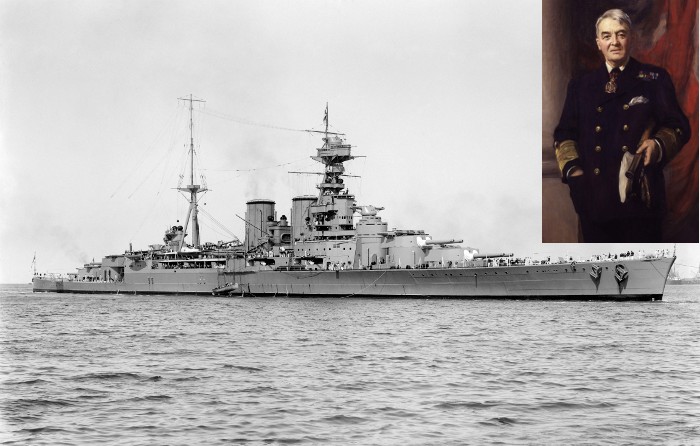
Above (main) is HMS Hood, the pride of the Royal Navy between the wars. Her construction was allowed under the terms of the Washington Naval Treaty that limited the tonnage and main armament of capital ships. Hood’s tragic history is well known of course. Her loss was not due to any mistakes made or failings of her commander or crew. They performed magnificently and their descendants and kinsfolk are justifiably very, very proud of them. Hood’s tactics against the Bismarck were spot on. Close the range ASAP (to minimise the danger of long range shell penetration of her weak deck armour) and go “gun to gun” with her. We know that Bismarck’s crew would have given every bit as she got and the losses on both sides would have been heavy as they ended up being in any event. The descendants and kinsfolk of Bismarck’s crew are justifiably very, very proud of them – as they should be. On both sides – now friends and allies – there is pride and sorrow that so many brave men gave up their tomorrows so early.
Today’s post however is about failure. Not the failure of brave men to perform adequately but of these men being the victims of a failure of an idea, a concept. That idea, that concept was the battle-cruiser.
The battle-cruiser was the brain child of Admiral of the Fleet, Lord Fisher (inset, above). He was the First Sea Lord and directed the Director of Naval Construction to have his staff design is brainchild.
This brainchild essentially was a warship that had the guns of a battleship and the speed of a cruiser. Lord Fisher’s idea was that the battle-cruiser could overwhelm cruisers with her battleship’s guns but flee or use her speed to prevent her from being struck by an enemy battleships shells. This because the battle-cruiser had little more than an armoured cruiser’s armour protection! Lord Fisher famously coined the phrase “speed is armour”.
Lord Fisher’s belief that speed was armour was wrong. Was proved wrong and resulted in squadrons of very expensive naval “white elephants” being commissioned into the Royal Navy, the Imperial German Navy and at the very end of WW2 the United States Navy (the Alaska class) who by that time should have known better!
At the time the Royal Navy was commissioning it’s battle-cruisers there was a naval race between the British and German empires which resulted in the Kaiser demanding that he would have battle-cruisers as well. Sensibly, the German naval architects worked in more armour to their ships than did their British opposite numbers.
The Battle of Jutland proved an expensive lesson for the Royal Navy in several ways, just one of which was that battle-cruisers needed greater protection – especially in deck armour. HMS Hood was part of a four ship “Admiral Class” and was the only one built. Over 10,000 tons of additional displacement was worked in to the design to increase her armour. This resulted in lowering her free-board and increasing her draft by 4 inches. On such a large ship this may appear inconsequential but it was critical. Hood’s design in any event meant that she would ship green water in a seaway, not only over her forecastle but down the weather-deck to midships. In addition her quarterdeck was cut away which meant that she would ship water in any following sea that was over sea state three! In other words, Hood was a wet ship. A very wet ship. This would have been bad enough but was made even worse by poor design of the bilge arrangements and sewage which meant that in a head sea over sea state five Hood’s forecastle would be semi-submerged which in addition to making the forward sections run with surface water, also caused raw sewage from the heads (toilets) to run across her lower decks. Not for nothing did her crew refer to her as the largest submarine in the Royal Navy.
That such a flawed design should have been proceeded with was not only a failure by the Admiralty. It was a failure by the political establishment. It demonstrates to us today that intelligent people can become the victims of a group think and ideas and projects that should never have got off the ground – did!
Prime Minister (as of today) Boris Johnson and his cabinet colleagues are victims of a similar group think folly. That the UK’s electricity supply should in large part be provided by building wind turbines and erecting them in the middle of the North Sea!
Making the UK dependent on the vagaries of the famously unpredictable British weather is an idea so stupid that even Lord Fisher would have rejected it!
At least we the long suffering and hard pressed customers of the privatised electricity supply industry are only going to have to pay with our pockets and not our lives!
